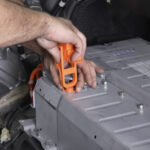Checking your tire pressure on a 2018 Toyota Camry is crucial for safety and optimal performance, and millertoyota.net is here to guide you through the process. We’ll show you how to ensure your tires are properly inflated, improving fuel efficiency, extending tire life, and ensuring a smooth, safe ride and discover expert tire maintenance at Miller Toyota in Boise. Plus, learn about related services like tire rotation and replacement.
1. Why Is Checking Tire Pressure Important for Your 2018 Toyota Camry?
Maintaining correct tire pressure in your 2018 Toyota Camry is important for several reasons, with proper tire inflation ensuring safety and optimal vehicle performance. Here are key benefits of monitoring and maintaining your tire pressure:
- Safety: Correctly inflated tires provide better handling and stability, reducing the risk of accidents. Underinflated tires can overheat and potentially lead to a blowout.
- Fuel Efficiency: Properly inflated tires reduce rolling resistance, which improves your Camry’s gas mileage. According to the U.S. Department of Energy, you can improve your gas mileage by up to 3.3% by keeping your tires inflated to the proper pressure.
- Tire Life: Maintaining the recommended tire pressure helps your tires wear evenly, extending their lifespan. Over or underinflated tires can cause uneven wear, leading to premature replacement.
- Ride Comfort: Correct tire pressure ensures a smoother and more comfortable ride. Overinflated tires can make the ride harsh, while underinflated tires can feel sluggish.
- Performance: Properly inflated tires provide optimal grip and handling, enhancing your vehicle’s performance in various driving conditions.
By regularly checking and maintaining your 2018 Toyota Camry’s tire pressure, you enhance safety, improve fuel efficiency, extend tire life, and enjoy a smoother, more comfortable ride.
2. Understanding Tire Pressure Monitoring System (TPMS) in Your 2018 Toyota Camry
Your 2018 Toyota Camry is equipped with a Tire Pressure Monitoring System (TPMS), designed to alert you when tire pressure drops significantly. Here’s what you should know about TPMS:
-
How TPMS Works: TPMS uses sensors in each tire to monitor air pressure. If the pressure falls below a certain threshold (usually 25% below the recommended pressure), the TPMS light on your dashboard will illuminate.
-
Types of TPMS: There are two main types of TPMS:
- Direct TPMS: Uses pressure sensors inside each tire to measure the specific tire pressure and transmit it to the vehicle’s computer.
- Indirect TPMS: Uses the vehicle’s antilock braking system (ABS) sensors to monitor the rotational speed of each wheel. If a tire loses pressure, its rotational speed changes, triggering the TPMS light.
-
Benefits of TPMS:
- Enhanced Safety: TPMS alerts you to low tire pressure, helping prevent tire blowouts and accidents.
- Improved Fuel Efficiency: By maintaining proper tire pressure, TPMS helps optimize fuel consumption.
- Extended Tire Life: TPMS helps you maintain even tire wear, prolonging the life of your tires.
-
Limitations of TPMS:
- Doesn’t Replace Manual Checks: TPMS is a valuable tool, but it doesn’t replace the need for regular manual tire pressure checks. It’s important to check your tire pressure manually to ensure accuracy.
- May Not Detect Gradual Leaks: TPMS is designed to detect significant drops in pressure. Slow leaks may not be detected until the pressure falls substantially.
-
TPMS Light Indicators:
- Solid Light: Indicates that one or more of your tires is significantly underinflated.
- Flashing Light: Indicates a malfunction in the TPMS system. This may require professional service.
Understanding your 2018 Toyota Camry’s TPMS can help you stay informed about your tire pressure and take appropriate action when needed. Remember to use TPMS in conjunction with regular manual tire pressure checks for optimal safety and tire maintenance.
3. Where to Find the Recommended Tire Pressure for Your 2018 Toyota Camry
Finding the recommended tire pressure for your 2018 Toyota Camry is simple. The information can be found in three primary locations:
-
Door Jamb Sticker: The most common location is on a sticker located on the driver’s side door jamb. Open the driver’s side door and look for a sticker that provides information about the recommended tire pressure, vehicle load capacity, and tire size.
-
Owner’s Manual: The owner’s manual for your 2018 Toyota Camry also contains the recommended tire pressure. Refer to the section on tires and wheels for this information.
-
Fuel Door: In some vehicles, the recommended tire pressure information may also be found on a sticker located on the fuel door.
The recommended tire pressure is usually listed in pounds per square inch (PSI). For example, the sticker might indicate a recommended pressure of 32 PSI for the front tires and 33 PSI for the rear tires. Always use the recommended tire pressure provided by Toyota, rather than the maximum pressure listed on the tire itself. The maximum pressure on the tire sidewall indicates the highest pressure the tire can safely handle, not the ideal pressure for your vehicle. According to Toyota Motor Corporation, using the recommended tire pressure ensures optimal handling, comfort, and tire wear for your 2018 Camry.
4. Step-by-Step Guide: How to Manually Check Your 2018 Toyota Camry Tire Pressure
Checking your tire pressure manually is a simple process. Here’s a step-by-step guide:
- Gather Your Tools: You’ll need a reliable tire pressure gauge. Digital gauges are generally more accurate than stick-type gauges.
- Find the Recommended Tire Pressure: Check the sticker on your driver’s side door jamb or your owner’s manual for the recommended PSI for your 2018 Toyota Camry.
- Check the Tires When Cold: For an accurate reading, check your tires when they are cold, ideally in the morning before you’ve driven the car. Driving heats up the tires, which can increase the air pressure inside and give you a false reading.
- Remove the Valve Cap: Unscrew the valve cap from the tire valve stem and set it aside in a safe place.
